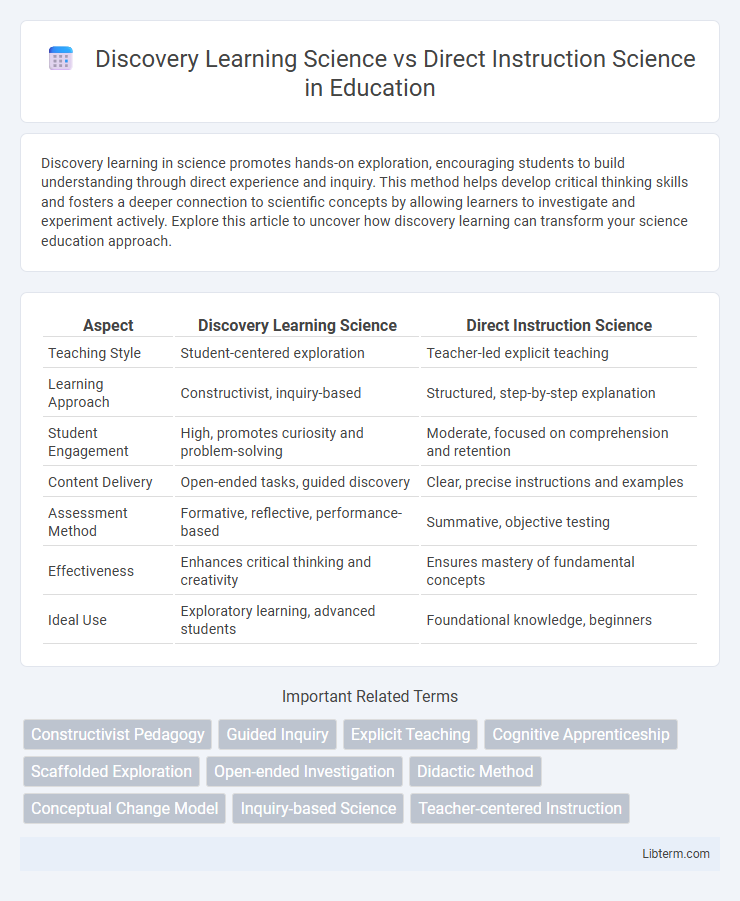Discovery learning in science promotes hands-on exploration, encouraging students to build understanding through direct experience and inquiry. This method helps develop critical thinking skills and fosters a deeper connection to scientific concepts by allowing learners to investigate and experiment actively. Explore this article to uncover how discovery learning can transform your science education approach.
Table of Comparison
| Aspect | Discovery Learning Science | Direct Instruction Science |
|---|---|---|
| Teaching Style | Student-centered exploration | Teacher-led explicit teaching |
| Learning Approach | Constructivist, inquiry-based | Structured, step-by-step explanation |
| Student Engagement | High, promotes curiosity and problem-solving | Moderate, focused on comprehension and retention |
| Content Delivery | Open-ended tasks, guided discovery | Clear, precise instructions and examples |
| Assessment Method | Formative, reflective, performance-based | Summative, objective testing |
| Effectiveness | Enhances critical thinking and creativity | Ensures mastery of fundamental concepts |
| Ideal Use | Exploratory learning, advanced students | Foundational knowledge, beginners |
Overview of Discovery Learning Science
Discovery Learning Science emphasizes student-centered exploration where learners actively engage in experiments and problem-solving to construct understanding. This approach fosters critical thinking and inquiry skills by encouraging students to investigate scientific concepts through hands-on activities and questions. It contrasts with Direct Instruction Science, which relies on explicit teaching and structured guidance to convey scientific knowledge efficiently.
Defining Direct Instruction in Science
Direct Instruction in Science emphasizes structured, teacher-led lessons that deliver explicit explanations, step-by-step demonstrations, and guided practice to ensure mastery of scientific concepts and procedures. This approach relies on clear learning objectives, frequent assessments, and immediate feedback to reinforce understanding and correct misconceptions efficiently. Evidence shows Direct Instruction enhances measurable outcomes in foundational science skills, particularly in complex topics requiring precise knowledge acquisition.
Key Differences Between Discovery Learning and Direct Instruction
Discovery learning in science emphasizes student-driven exploration and inquiry, fostering critical thinking and problem-solving through hands-on experiments and open-ended questions. Direct instruction, by contrast, relies on explicit teaching methods with structured lessons, clear objectives, and step-by-step guidance to ensure mastery of scientific concepts. Key differences include the role of the teacher as a facilitator in discovery learning versus an instructor in direct instruction, and the learner's autonomy in constructing knowledge versus receiving information in a predefined sequence.
Cognitive Theories Supporting Each Approach
Discovery learning in science is grounded in constructivist cognitive theories such as Piaget's stages of cognitive development and Vygotsky's social constructivism, emphasizing active exploration and knowledge construction through hands-on experiences. Direct instruction is supported by information-processing theories and cognitive load theory, promoting structured, explicit teaching to efficiently manage working memory and facilitate schema acquisition. Both approaches leverage different cognitive pathways: discovery learning fosters meaningful understanding via experiential engagement, while direct instruction ensures mastery through systematic guidance and repetition.
Impact on Student Engagement and Motivation
Discovery learning science fosters student engagement by encouraging active exploration and hands-on experimentation, which enhances intrinsic motivation and curiosity. Direct instruction science provides structured guidance, helping students grasp complex concepts quickly but may limit opportunities for autonomous problem-solving. Combining both methods can optimize motivation by balancing clear explanations with meaningful discovery experiences.
Effectiveness in Building Scientific Understanding
Discovery learning in science promotes active engagement and critical thinking, enabling students to explore concepts through hands-on experiments, which can lead to deeper conceptual understanding. Direct instruction provides clear, structured explanations and guided practice, often resulting in faster acquisition of foundational scientific knowledge and procedural skills. Research indicates that combining discovery learning with direct instruction yields the most effective outcomes, enhancing both intuitive grasp and factual mastery of scientific principles.
Classroom Implementation Challenges
Discovery learning in science presents challenges such as increased time requirements and student frustration due to ambiguous guidance, which can hinder content mastery. Direct instruction offers structured pacing and clear objectives, yet may reduce opportunities for critical thinking and student engagement during hands-on activities. Balancing the exploratory nature of discovery learning with the clarity of direct instruction demands careful planning to address diverse learner needs and maintain classroom management.
Assessment Methods for Both Approaches
Assessment methods in Discovery Learning Science emphasize formative approaches, including observation, student self-assessments, and open-ended tasks that gauge conceptual understanding and problem-solving skills. In Direct Instruction Science, assessments are often summative, featuring quizzes, standardized tests, and structured exercises designed to measure specific factual knowledge and procedural proficiency. Each method's assessment aligns with its pedagogical goals: Discovery Learning prioritizes deep comprehension and application, while Direct Instruction focuses on clear, measurable learning outcomes.
Best Practices for Integrating Both Methods
Combining Discovery Learning and Direct Instruction in science education enhances comprehension by balancing student-led exploration with structured guidance, ensuring foundational concepts are clearly understood. Best practices include initiating lessons with direct instruction to establish key principles, followed by guided discovery activities that promote critical thinking and application of scientific methods. Integrating formative assessments throughout enables educators to adjust instruction dynamically, supporting diverse learner needs and maximizing educational outcomes.
Future Trends in Science Education Strategies
Future trends in science education increasingly emphasize a balanced integration of Discovery Learning Science and Direct Instruction Science to foster critical thinking and foundational knowledge. Adaptive technologies and AI-driven platforms are enabling personalized learning pathways that combine interactive exploration with targeted instruction for enhanced student engagement and comprehension. Emphasizing inquiry-based labs alongside structured guidance prepares learners for complex problem-solving and real-world scientific challenges.
Discovery Learning Science Infographic

 libterm.com
libterm.com